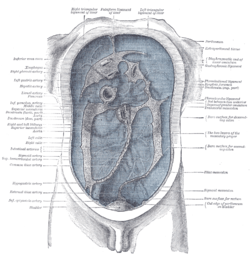Left triangular ligament
From Wikipedia, the free encyclopedia
| Ligament: Left triangular ligament | ||
|---|---|---|
 | ||
| The superior surface of the liver. | ||
| Latin | ligamentum triangulare sinistrum hepatis | |
| Gray's | p.1193 | |
| From | ||
| To | ||
| Dorlands/Elsevier | l_09/12493479 | |
The left triangular ligament is a fold of some considerable size, which connects the posterior part of the upper surface of the left lobe of the liver to the diaphragm; its anterior layer is continuous with the left layer of the falciform ligament.
Additional images
-

Diagram to show the lines along which the peritoneum leaves the wall of the abdomen to invest the viscera.
External links
- liver at The Anatomy Lesson by Wesley Norman (Georgetown University) (liversuperior)
- 38:10-0103 at the SUNY Downstate Medical Center - "Stomach, Spleen and Liver: Ligaments of the Liver"
- SUNY Anatomy Image 7872
This article incorporates text from a public domain edition of Gray's Anatomy.
| ||||||||||||||||||||||||||||||||||
This article is issued from Wikipedia. The text is available under the Creative Commons Attribution/Share Alike; additional terms may apply for the media files.